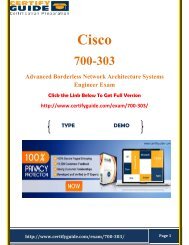You also want an ePaper? Increase the reach of your titles
YUMPU automatically turns print PDFs into web optimized ePapers that Google loves.
<strong>Citrix</strong><br />
1Y0-351<br />
<strong>Citrix</strong> NetScaler 10.5 Essentials and Networking<br />
Click the Link Below To Get Full Version<br />
http://www.certifyguide.com/exam/1Y0-351/<br />
http://www.certifyguide.com/exam/1Y0-351/ Page 1
Question: 1<br />
A network engineer needs to upgrade both appliances of a High Availability (HA) pair.<br />
In which order should the network engineer upgrade the appliances<br />
A. Disable high availability and upgrade one node at a time.<br />
B. Upgrade the primary node first without disabling high availability.<br />
C. Upgrade the secondary node first without disabling high availability.<br />
D. Perform the upgrade simultaneously without disabling high availability.<br />
Question: 2<br />
Answer: C<br />
Scenario: A network engineer is managing a NetScaler environment that has two NetScaler devices<br />
running as a high availability pair. The engineer must upgrade the current version from NetScaler 9 to<br />
NetScaler 10.5.<br />
Which action must the engineer take<br />
A. Upgrade the primary node and perform HA sync.<br />
B. Upgrade the secondary node and then upgrade the primary node.<br />
C. Upgrade the primary node and then upgrade the secondary node.<br />
D. Break the high availability pair, upgrade each NetScaler device, and then reconfigure high availability.<br />
Question: 3<br />
Answer: B<br />
An engineer has two NetScaler devices in two different datacenters and wants to create a high<br />
availability (HA) pair with the two devices, even though they are on two different subnets.<br />
How can the engineer configure the HA Pair between the two NetScaler devices<br />
A. Configure StaySecondary on the second datacenter appliance.<br />
B. Ensure that INC mode is enabled during the creation of the HA Pair.<br />
C. Enable the HAMonitors on all interfaces after the HA Pair has been created.<br />
D. Change the NSIP of the second appliance to be on the same subnet as the first appliance.<br />
http://www.certifyguide.com/exam/1Y0-351/ Page 2
Answer: B<br />
Question: 4<br />
When a network engineer logs onto a new NetScaler device in the London datacenter, data output<br />
indicates that the device is NOT configured for the local time.<br />
How can the network engineer synchronize the correct time with an NTP server in the local data center<br />
A. Configure the correct time from the GUI and restart.<br />
B. Modify the ntp.conf and rc.netscaler files and restart.<br />
C. Logon using the nsrecover/nsroot credentials and restart.<br />
D. Configure the NetScaler as a secondary NTP server and restart.<br />
Question: 5<br />
Answer: B<br />
Scenario: The NetScaler has connections to a large number of VPNs. The network engineer wants to<br />
minimize the number of ARP requests.<br />
Which feature should the network engineer enable to minimize ARP requests<br />
A. TCP Buffering<br />
B. Use Source IP<br />
C. Edge Configuration<br />
D. MAC based forwarding<br />
Question: 6<br />
Answer: D<br />
A network engineer has configured two NetScaler MPX appliances as a high availability (HA) pair.<br />
What can the engineer configure to prevent failover if only a single interface fails<br />
A. FIS<br />
B. PBR<br />
C. SNMP<br />
D. VMAC<br />
http://www.certifyguide.com/exam/1Y0-351/ Page 3
Answer: A<br />
Question: 7<br />
Scenario: A NetScaler appliance currently has a manually configured channel containing four interfaces;<br />
however, the engineer has been told that the NetScaler must now only use a single interface for this<br />
network. The engineer removes the channel and immediately notices a decrease in network<br />
performance.<br />
How could the engineer resolve this issue<br />
A. Reset the unused interfaces<br />
B. Disable the unused interfaces<br />
C. Enable flow control on all interfaces<br />
D. Disable HA monitoring on the three interfaces that are no longer required<br />
Question: 8<br />
Answer: B<br />
Scenario: A NetScaler engineer needs to enable access to some web servers running on an IPv6-only<br />
network. The clients connecting the services are on an IPv4 network. The engineer has already enabled<br />
IPv6 on the NetScaler.<br />
What does the engineer need to do in order to provide access to the services on the IPv6 network<br />
A. Create an IPv6 tunnel and a IPv4 virtual server.<br />
B. Configure an IPv6 VLAN and bind the required interface.<br />
C. Create a IPv4 virtual server and bind the service group to it.<br />
D. Create an IPv6 ACL and a IPv4 virtual server and bind the ACL to the virtual server.<br />
Question: 9<br />
Answer: C<br />
Scenario: A network engineer created an IPv6 virtual server on the NetScaler. The virtual server is using<br />
a service group with two IPv4 servers bound to it. When testing access to the virtual server from a client<br />
configured with an IPv6 address, he is unable to connect.<br />
What could be the reason for this issue<br />
A. The NetScaler is disabled for NAT.<br />
http://www.certifyguide.com/exam/1Y0-351/ Page 4
B. IPv6 protocol translation is disabled.<br />
C. An IPv6 address on the NetScaler is not bound to the correct VLAN.<br />
D. The NetScaler does not have an INAT rule to convert IPv4 to IPv6 from the back-end servers.<br />
Question: 10<br />
Answer: B<br />
Scenario: An engineer executes the following commands:<br />
add vlan 2<br />
bind vlan 2 -ifnum 1/2<br />
add ns ip 10.110.4.200 255.255.255.0<br />
bind vlan 2 -IPAddress 10.110.4.200 255.255.255.0<br />
What type of IP address has been added to the NetScaler<br />
A. VIP address<br />
B. NSIP address<br />
C. SNIP address<br />
D. GSLB Site IP address<br />
Question: 11<br />
Answer: C<br />
Scenario: For security reasons, the NSIP needs to be configured to only be accessible on interface 0/1,<br />
which is VLAN 300.<br />
The NSIP address is 10.110.4.254 and the subnet mask is 255.255.255.0.<br />
How would the network engineer achieve this configuration<br />
A. set ns config -nsvlan 300 -ifnum 0/1<br />
B. set ns ip 10.110.4.254 -gui ENABLED -vrID 300<br />
C. add vlan 300<br />
set ns ip 10.110.4.254 -mgmtAccess ENABLED<br />
D. set ns config -IPAddress 10.110.4.254 -netmask 255.255.255.0<br />
Question: 12<br />
Answer: A<br />
http://www.certifyguide.com/exam/1Y0-351/ Page 5
Why would an engineer want to specify a TCP Profile for a specific service group<br />
A. To enable use of features like SSL over TCP for that specific service group.<br />
B. To adjust the TCP settings for traffic to and from that specific service group.<br />
C. To use a specific SNIP for traffic to the back-end servers in that service group.<br />
D. To enable features like use source IP, TCP keep alive and TCP buffering for a specific service group.<br />
Question: 13<br />
Answer: B<br />
A network engineer wants to optimize a published load balanced SSL virtual server for WAN connection<br />
with long delay, high bandwidth with minimal packet drops.<br />
What would the network engineer use to do this type of optimization for the SSL virtual server<br />
A. SSL policy<br />
B. TCP profile<br />
C. Compression policy<br />
D. Priority queuing policy<br />
Question: 14<br />
Answer: B<br />
Scenario: The NetScaler is connected to two subnets. The NSIP is 10.2.9.12. The external SNIP is 10.2.7.3.<br />
The MIP for internal access is 10.2.9.3. Web servers, authentication servers and time servers are on the<br />
10.2.10.0/24 network which is available through the 10.2.9.1 router. The external firewall has the<br />
10.2.7.1 address. Traffic bound for Internet clients should flow through the external firewall.<br />
Which command should be used to set the default route<br />
A. add route 0.0.0.0 0.0.0.0 10.2.7.1<br />
B. add route 0.0.0.0 0.0.0.0 10.2.9.1<br />
C. add route 10.0.0.0 255.0.0.0 10.2.9.1<br />
D. add route 10.0.0.0 255.0.0.0 10.2.7.1<br />
Question: 15<br />
Answer: A<br />
http://www.certifyguide.com/exam/1Y0-351/ Page 6
Some SSL certificate files may be missing from a NetScaler appliance.<br />
Which directory should an engineer check to determine which files are missing<br />
A. /nsconfig/ssl<br />
B. /nsconfig/ssh<br />
C. flash/nsconfig/<br />
D. /var/netscaler/ssl/<br />
Question: 16<br />
Answer: A<br />
Scenario: An engineer has been hired to manage the content-switching configurations on the NetScaler.<br />
The user account for this engineer must have the standard rules that apply to the other administrators.<br />
What should the engineer do to allow for the extra privileges<br />
A. Modify the current Command Policy and then save the changes.<br />
B. Unbind the current Command Policy of the user account and then save the changes.<br />
C. Remove the custom Command Policy and then create one with the new requirements.<br />
D. Create a custom Command Policy and bind it to the user account with the highest priority.<br />
Answer: D<br />
http://www.certifyguide.com/exam/1Y0-351/ Page 7
<strong>Citrix</strong><br />
1Y0-351<br />
<strong>Citrix</strong> NetScaler 10.5 Essentials and Networking<br />
Click the Link Below To Get Full Version<br />
http://www.certifyguide.com/exam/1Y0-351/<br />
Thanks for Using Our Product<br />
http://www.certifyguide.com/exam/1Y0-351/ Page 8
















